Headless guitars seem to be all the rage these days (okay, so maybe a few years ago), but good ones have always been prohibitively expensive. For those of us who don’t want to–or can’t–spend Strandberg or Kiesel money, the options are few and far between. But NK Guitars is here to turn that on its head and offer everyone a beast of a guitar.
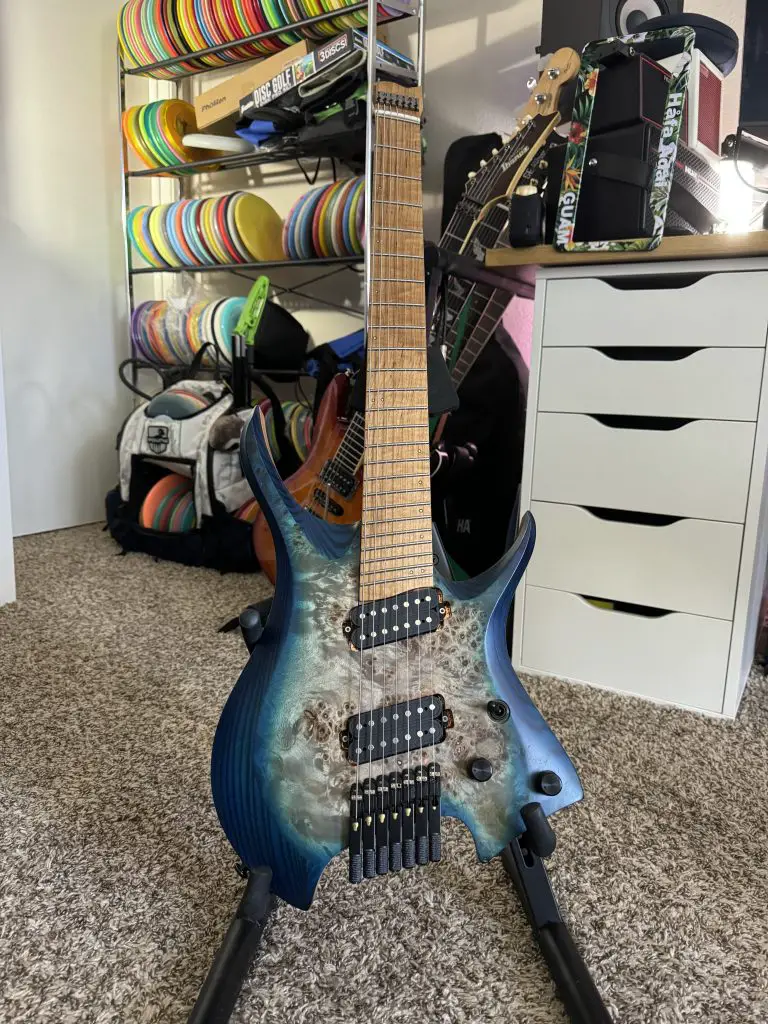
NK 2021 headless multiscale 7-string guitar review at a glance
-
Build
-
Playability
-
Features
-
Electronics
-
Price
-
Finish
The verdict
The NK 2021 headless multiscale 7-string guitar is a budget-friendly modern metal machine that punches above its weight to provide an excellent guitar-playing experience. If you’ve been curious about headless multiscale guitars but are hesitant to pay the big bucks for a competing brand, the NK guitars may be the right choice for you.
Pros
- Plays incredibly well out of the box with minimal adjustments necessary
- Fretwork is quite excellent
- Finish is top-notch
- Affordable compared to its true competitors
- Higher quality than most other “budget” guitars with these features
- Pickups will get the job done
Cons
- Shipping time from China may vary–and may be quite long
- Pickups aren’t the best, despite getting the job done
- Not often available on Amazon
Contents
Who are NK Guitars?
To be completely honest, before starting this journey I hadn’t heard of the brand. Not surprising, seeing as it’s a tiny operation in China. There isn’t really a website or social media presence outside of a rarely-updated NK Guitars Facebook page, and details are sparse.
From what I can see, however, it’s a mostly one-man operation building in a China-based location. This means that turnaround time can be somewhat slow for many orders, on top of the fact that it’s shipping from China. I’ve also seen reports of slow message responses as well according to the NK Headless Guitars Owners Club Facebook group, but if it’s really a one-man operation, it makes sense.
The fact that NK builds some highly reliable and well-built guitars for so little money makes up for these drawbacks. They manage to turn out instruments that punch well above their weight and have built a very loyal following because of this.
Why buy an NK Guitar?
I was in the market for what I like to call a “couch guitar”. Something that has a smaller body size while maintaining the full-scale length and would be easier to play while on the couch watching TV.
Many headless guitars are great for this because of the chopped-down body and reduced overall length thanks to the removal of the headstock. This makes them excellent lightweight instruments for jamming around the house.
Add to that the fact that I didn’t own a 7-string at the time and I’ve also been curious about multiscale necks combined with a severe case of G.A.S. (gear acquisition syndrome), and I decided it was time to buy my first guitar in over 5 years.
But I didn’t want to spend that much money and soon found myself scouring cheap guitars on Amazon. After encountering some brands there and doing some research, it led me to AliExpress and subsequently to NK Guitars.
What I ended up getting was an absolute shock. You hear the horror stories of buying AliExpress or Amazon guitars and expect at least a substantial degree of disappointment. Not so with NK Guitars–these instruments have no business being as good as they are, especially anywhere close to this price range.
Design and build quality
If there’s one consistent reaction to NK Guitars it’s that they’re built to a quality that far supersedes their price points. Aside from an occasional imperfect pickup cavity route, NK does a great job of ensuring quality control and keeping the defects to a minimum.
Let’s start with the specs of this particular guitar, at least to the best of my ability from the AliExpress page.
- Body: Ash with satin burl-ish finish
- Neck construction: bolt-on with recessed carving, ergonomic asymmetric neck profile
- Neck: Roasted maple with satin finish
- Fretboard: Flame maple
- Fretboard radius: 16″
- Fret markers: Luminous dot inlays on the fingerboard and side
- Truss rod: Dual-action
- Scale length: 25.5″-26.5″ (647.7-673.1mm)
- Frets: 24
- Nut: 47.5mm bone nut
- Pickups: Artecsound humbucker in bridge and neck
- Controls: 3-way pickup selector, one volume with a push-pull coil split, one tone
- Case: NK Guitars gig bag
- Weight: Approx. 3.0 kg (6.61 lbs) </ul>
Body style and design
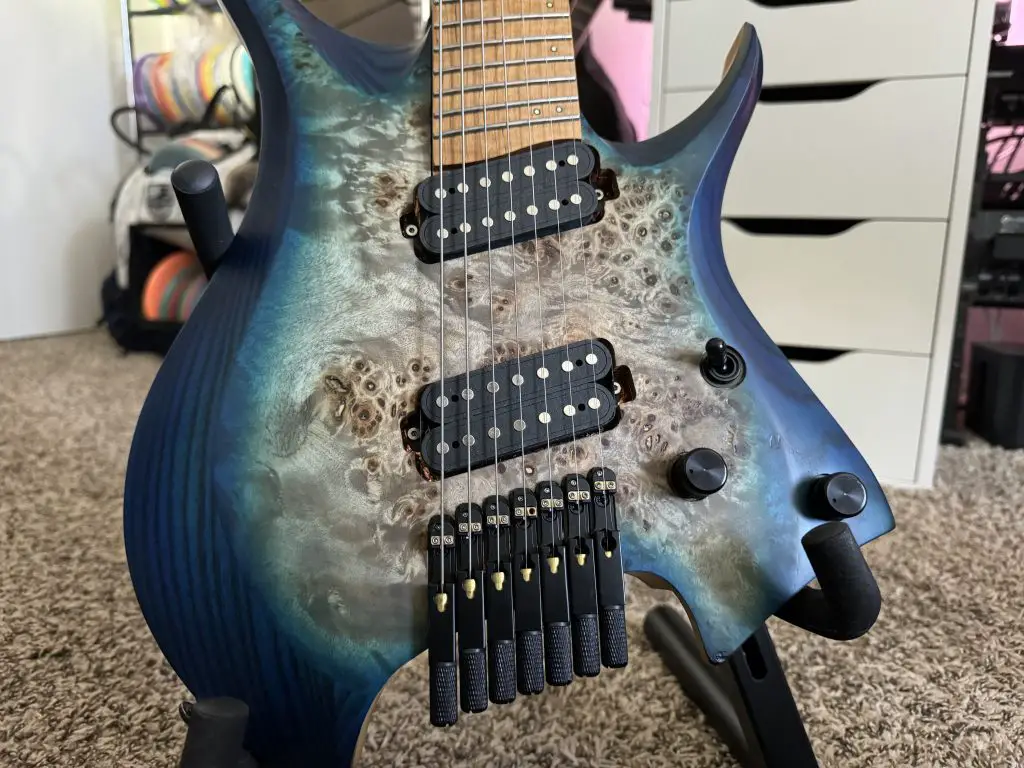
There’s no mistaking the body design as an homage to the Strandberg Boden. Somewhere around 8 years ago, Strandberg actually open-sourced their design, and while they seem to have removed the page from their site since then, they do state on their current About page that many of their designs are licensed under the Creative Commons Share-And-Share-Alike 3.0 Licensing.
This means that manufacturers, such as NK, are allowed to use these designs without any negative repercussions. Not that no one’s ever copied the Strat or Les Paul, but it’s nice to see a brand openly advocate for sharing designs.
As a result, the 2021 NK body is very familiar to fans of the Boden. But where the Boden is mostly squared off at its edges, the NK body has beautiful tapering and cuts along its borders. This takes a relatively flat-looking boxy guitar and softens it.
This means that the NK body is extremely comfortable to wear, hold, and play. The forearm taper isn’t nearly as pronounced as the Boden, but the rest of the design picks up the slack in my book.
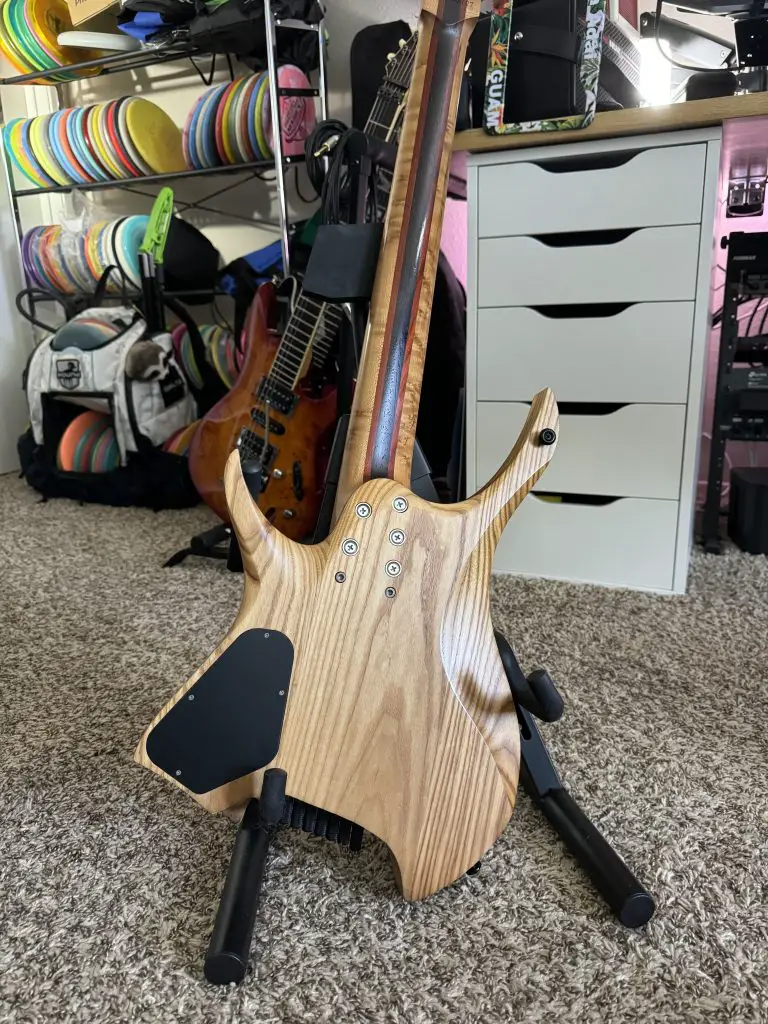
Where many budget guitar manufacturers start reducing body cuts, bevels, tapers, and the like, NK bodies go the opposite way and look extremely sophisticated.
It should be noted that NK does actually have a more direct Strandberg-style body, copying the Boden body style much more closely, removing the bevels and elongated bouts found in the body style of my NK, and adding the rounder edge below your forearm. They don’t have any available on the NK Guitars AliExpress store currently, but they do show up on the used market frequently enough.
At first, I wasn’t a huge fan of this particular roundness, preferring the NK original body variant instead, but I feel like I’m coming back around to the Boden version and may pick one up in the future.
Neck
The neck on an NK is among the best I’ve played. The satin finish is a blessing, and the (presumably) jumbo frets make for a great playing experience. Even getting used to a multiscale layout was a breeze on this neck.
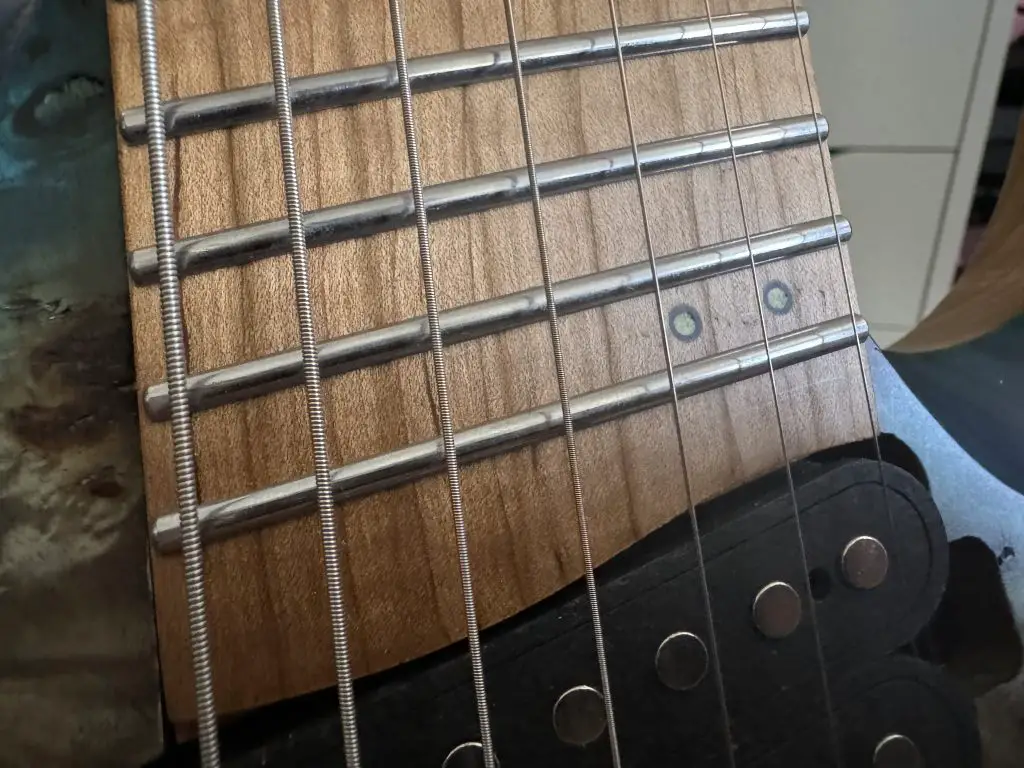
But the standout to me is the ergonomic asymmetric neck profile. What this means is that the neck shallows out the closer you get toward the body, narrowing down on the bass side and ultimately making fast runs and leads extremely easy to play.
It should be noted that this is similar to Strandberg’s EndurNeck, another asymmetrical neck profile. Unlike their body design, the EndurNeck is patented, so the NK design is not an identical copy, but more on this later now that I have a Strandberg.
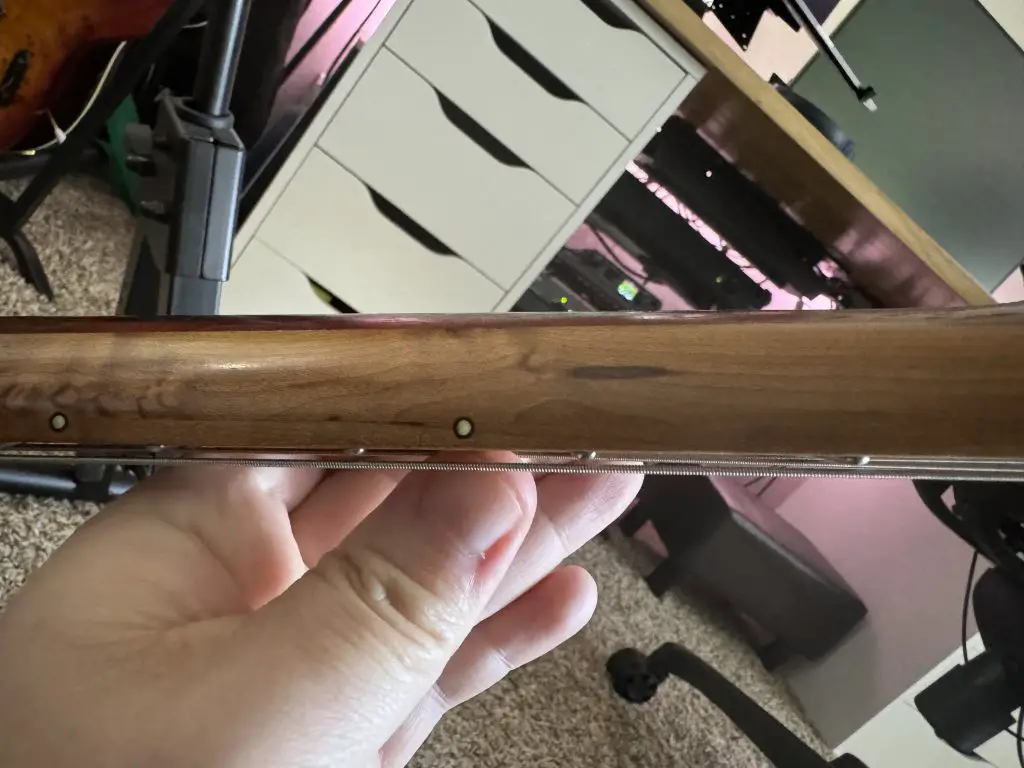
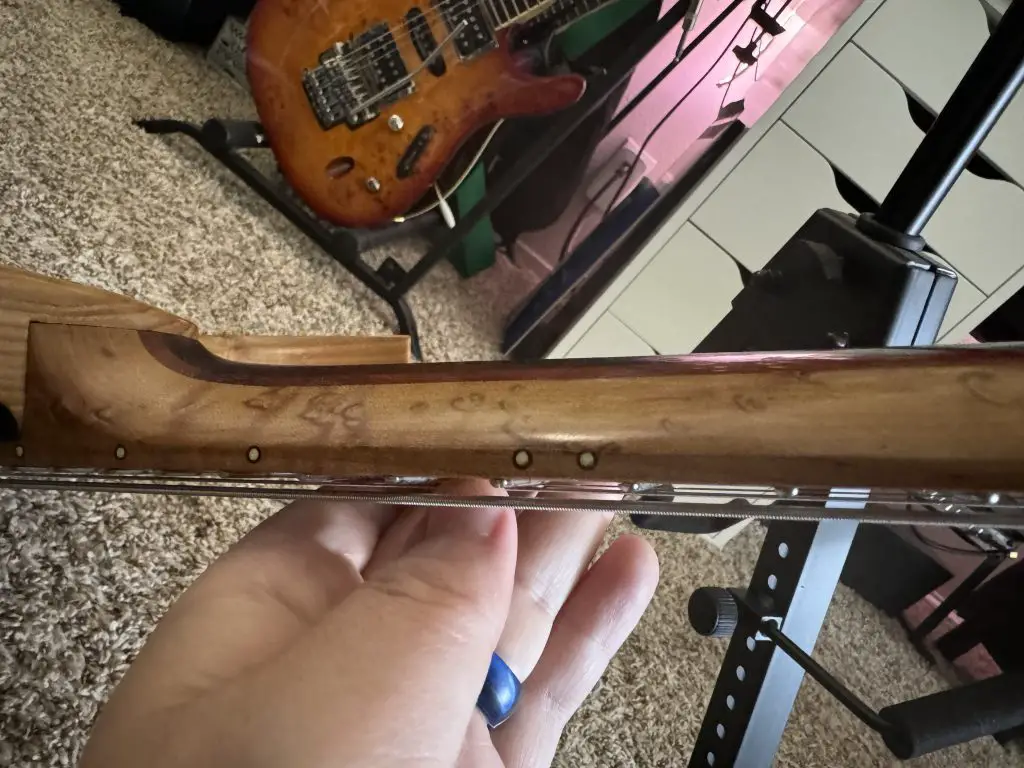
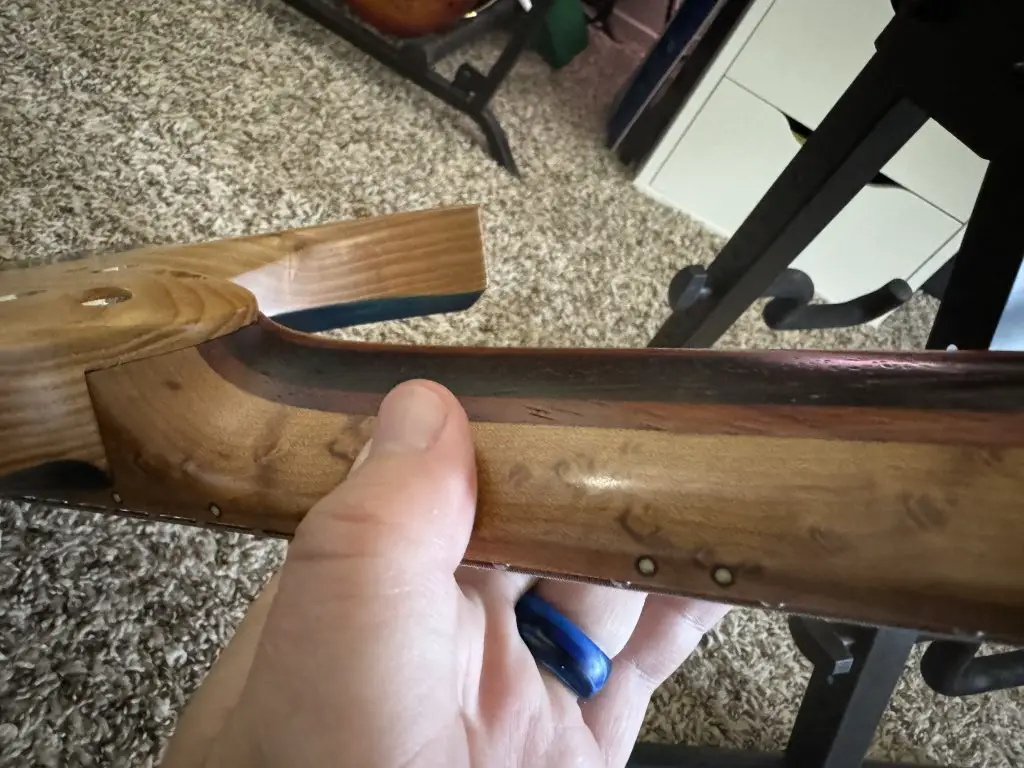
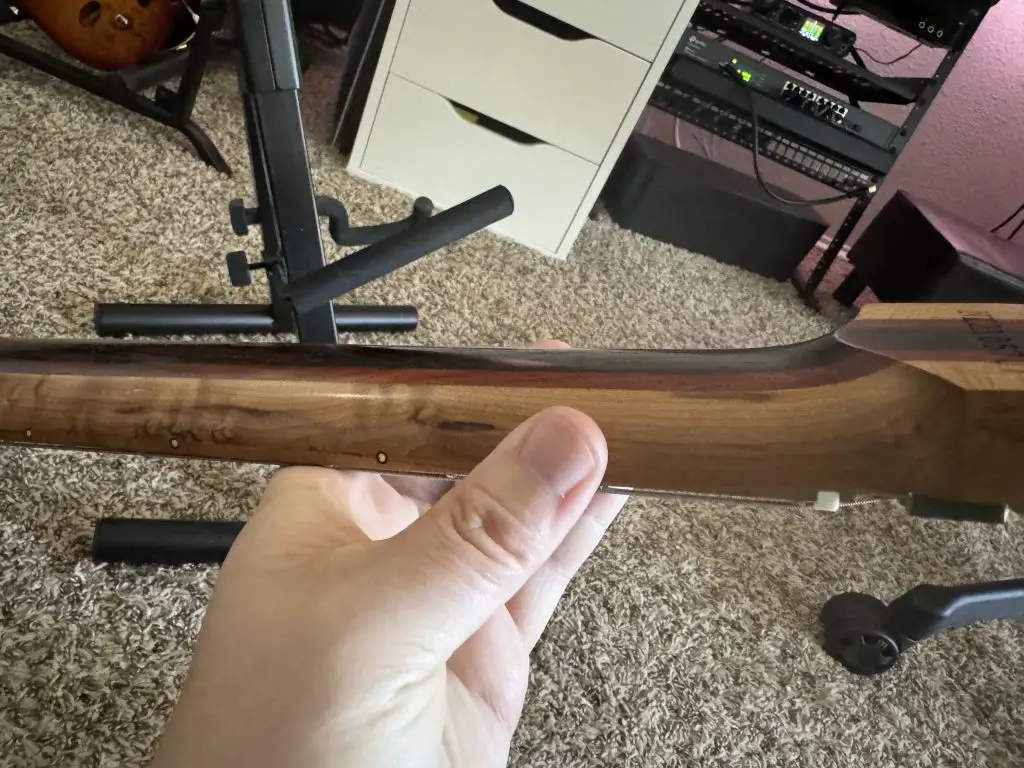
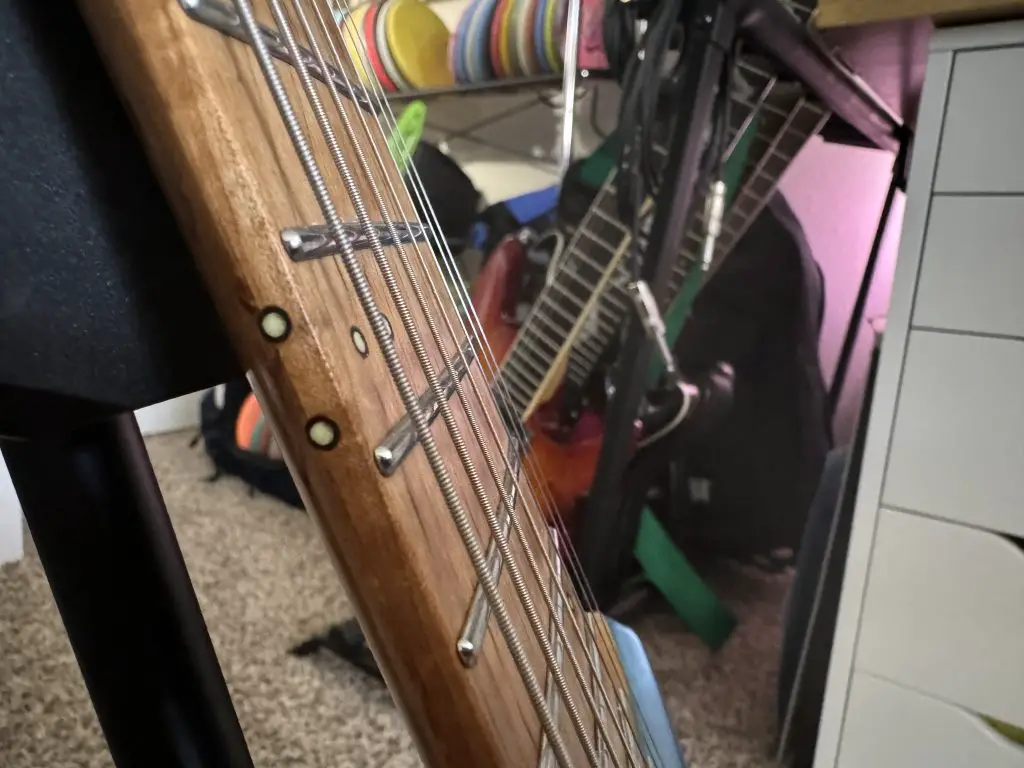
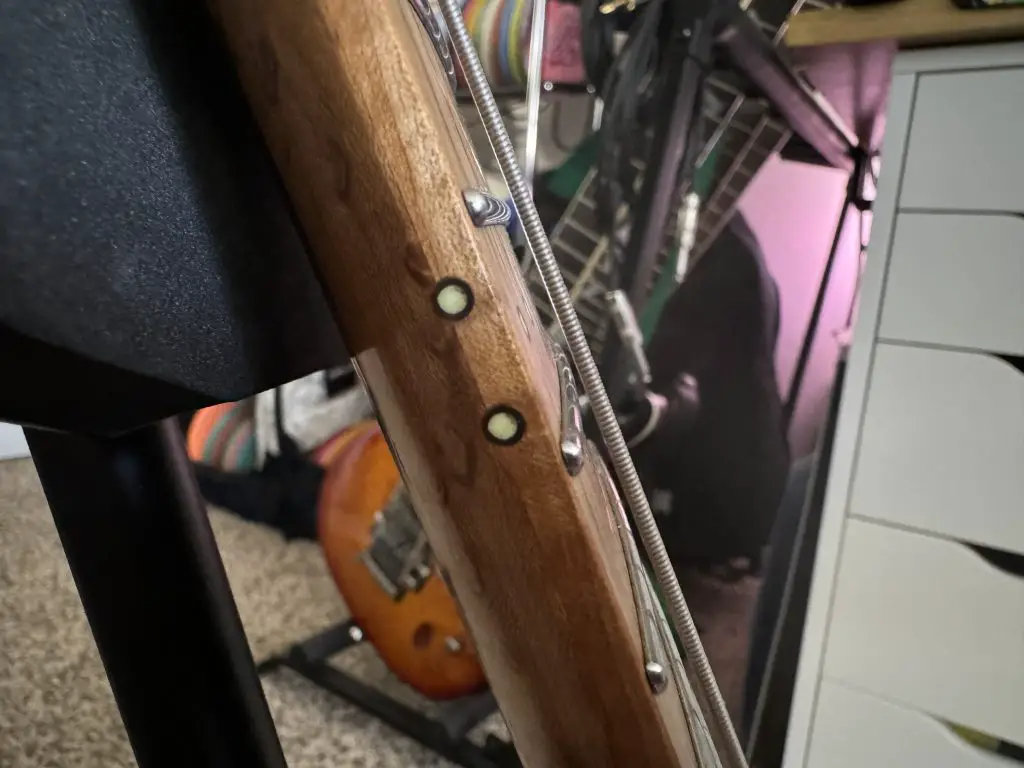
Even if you’re not looking for an extended-range guitar and want a six-string non-multiscale instrument, this neck profile will make playing higher up on the fretboard a dream.
As for adjustment, the truss rod is accessible from the end of the neck, making it easy to adjust relief without needing to remove the neck from the body. NK necks are usually pretty great off of the factory floor anyway, so any adjustment needed is usually pretty minor.
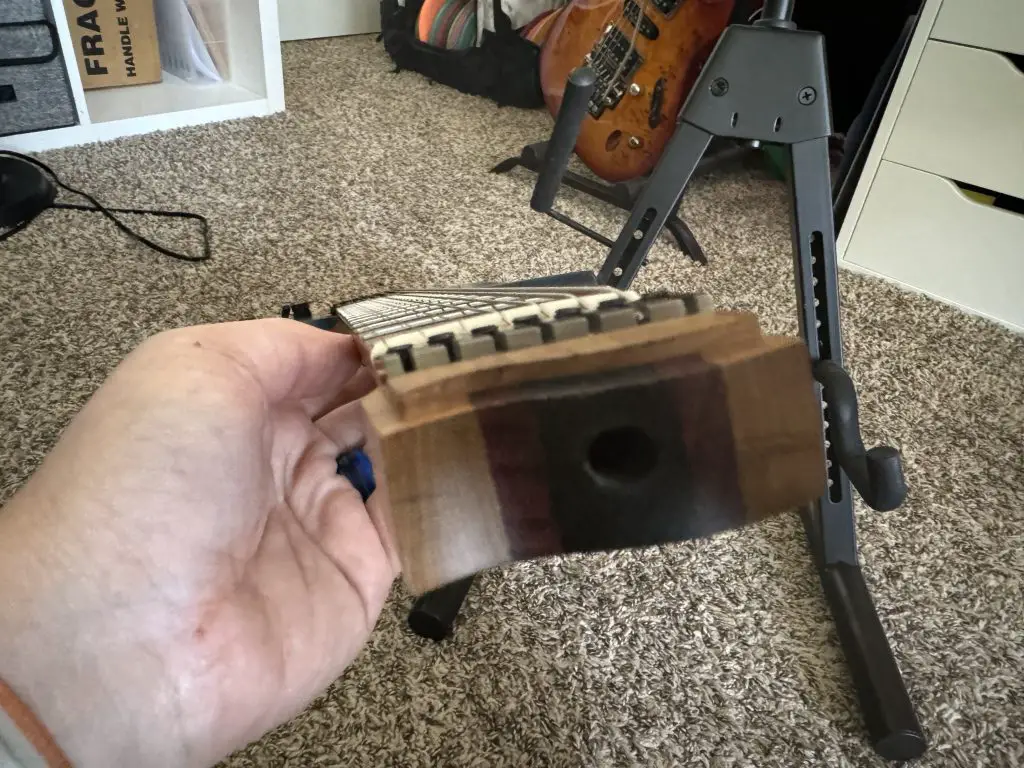
I almost forgot about the neck joint, which should be considered a good thing. I rarely even think about this part of the guitar because it’s just that good and out of the way. The neck joint is a substantial contributing factor to its playability though, and allows for access to the higher frets and feels great while playing up there.
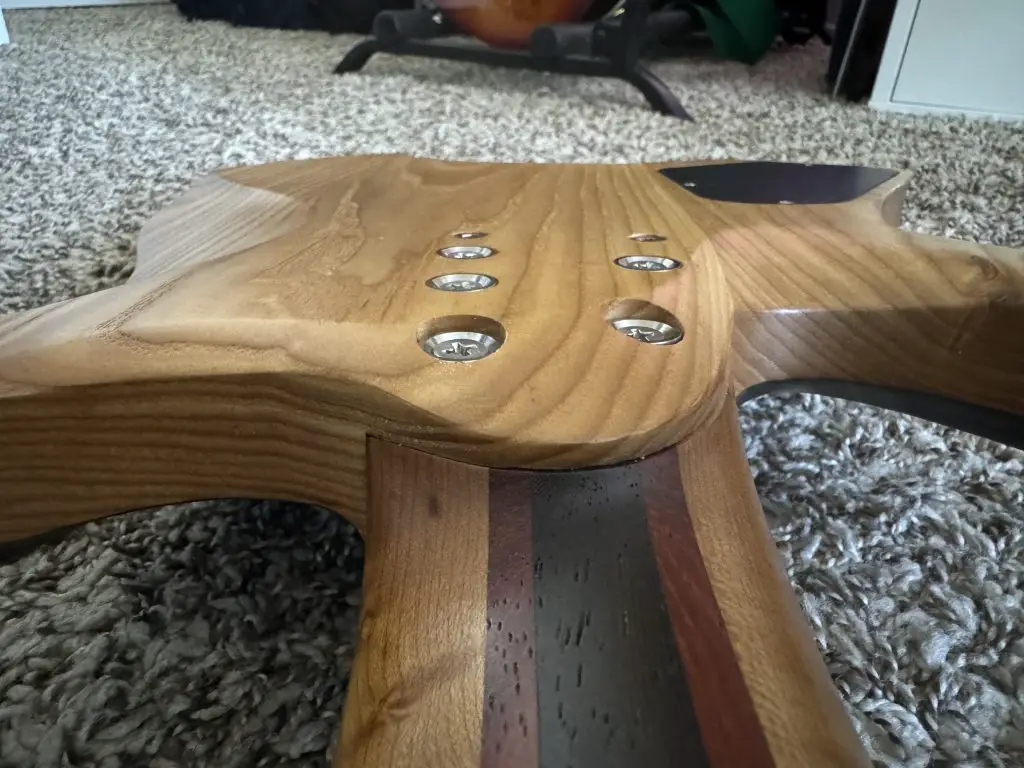
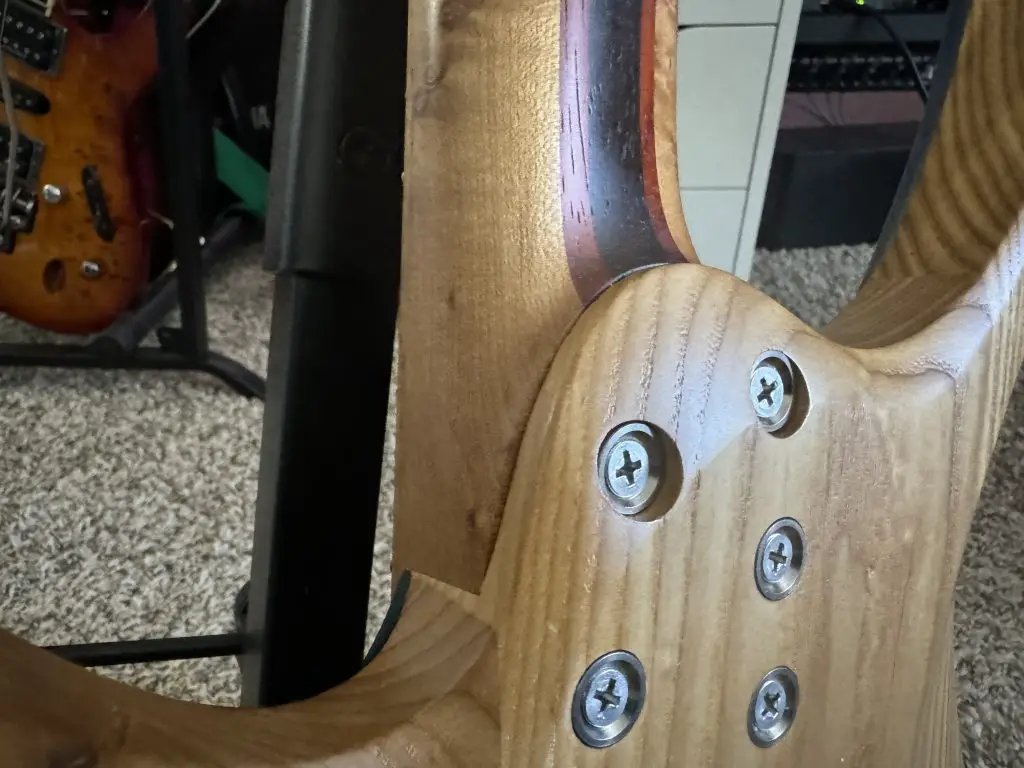
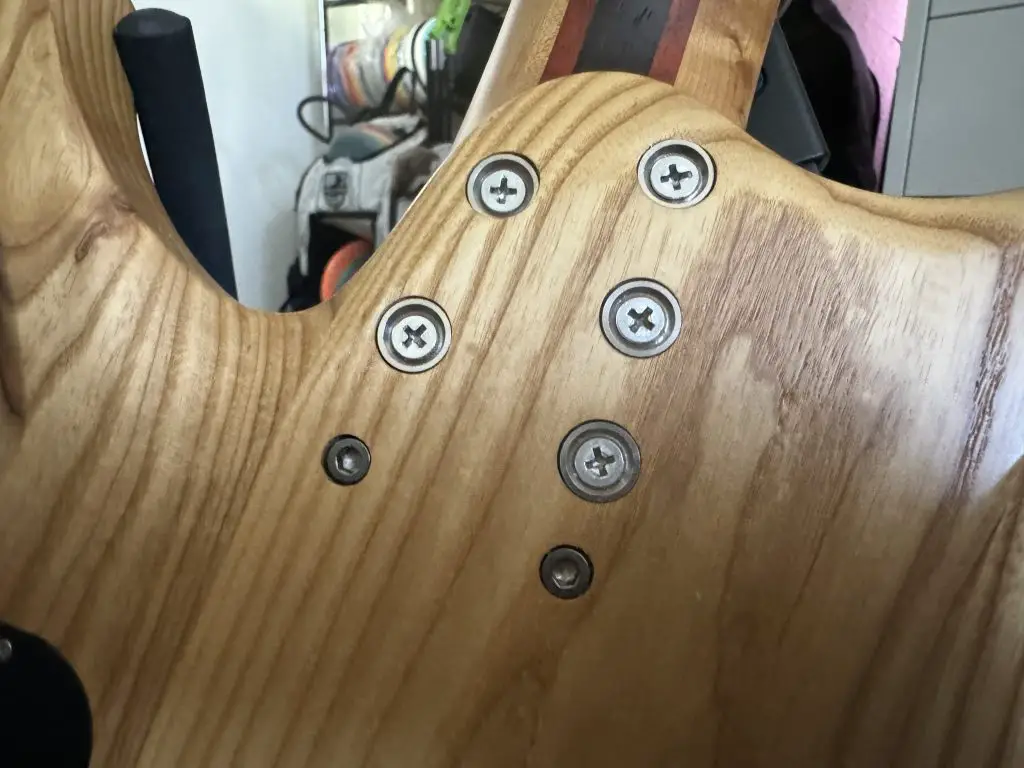
You won’t see the extremely fancy contouring on something like an Abasi Concepts Legion, but at this price point, you love to see these sorts of niceties.
Hardware
Pickups
The most commonly called-out downside to these guitars is that the pickups aren’t anything special. This is pretty accurate. Are they bad? No. Can you gig or record with them? Sure. Especially high-gain guitar tones, where pickups don’t really matter too much.
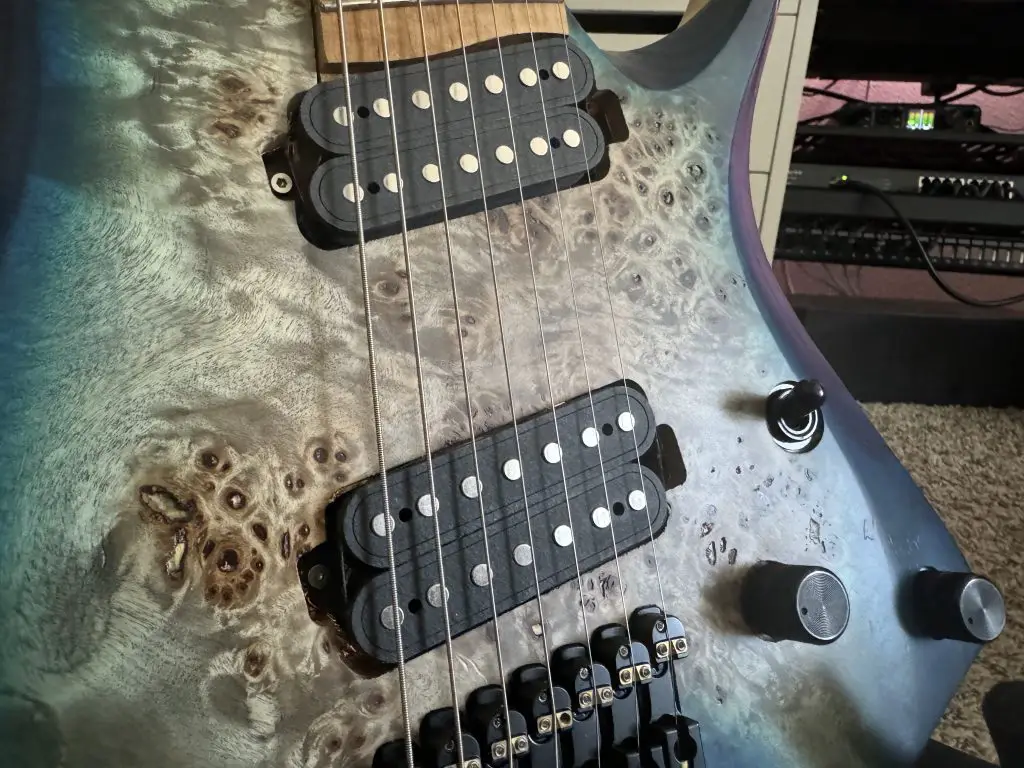
According to the product page, these are Artecsound humbuckers, probably identical in both bridge and neck positions (I haven’t taken mine apart yet, but will update this if I do). The Artecsound pickup lineup seems to have a single 7-string humbucker, so that’s most likely it.
But to be real, they sound decent enough for a casual player to not need anything different. Do they sound as good as my Schecter C-1 Platinum with active EMG 81/85s? Eh, I guess not. But those are classic pickups–active-powered high-gain monsters that built the metalcore world. Do I feel like my NK is inferior because of it? Nope, not one bit.
Thankfully, swapping pickups is pretty easy, even on the 7-string models. You may not be able to use all pickups, but if there’s a removable baseplate that you can swap to get the right angle on, then you’re good as gold.
Tone and volume controls
The controls are pretty straightforward on all NK guitars. Usually, there’s a three-position pickup selector, a volume, and a tone. Often there’s a push-pull coil split on the volume knob, and thankfully this model has it as well.
The hardware controls aren’t anything special, but they don’t leave any desires either.
Bridge
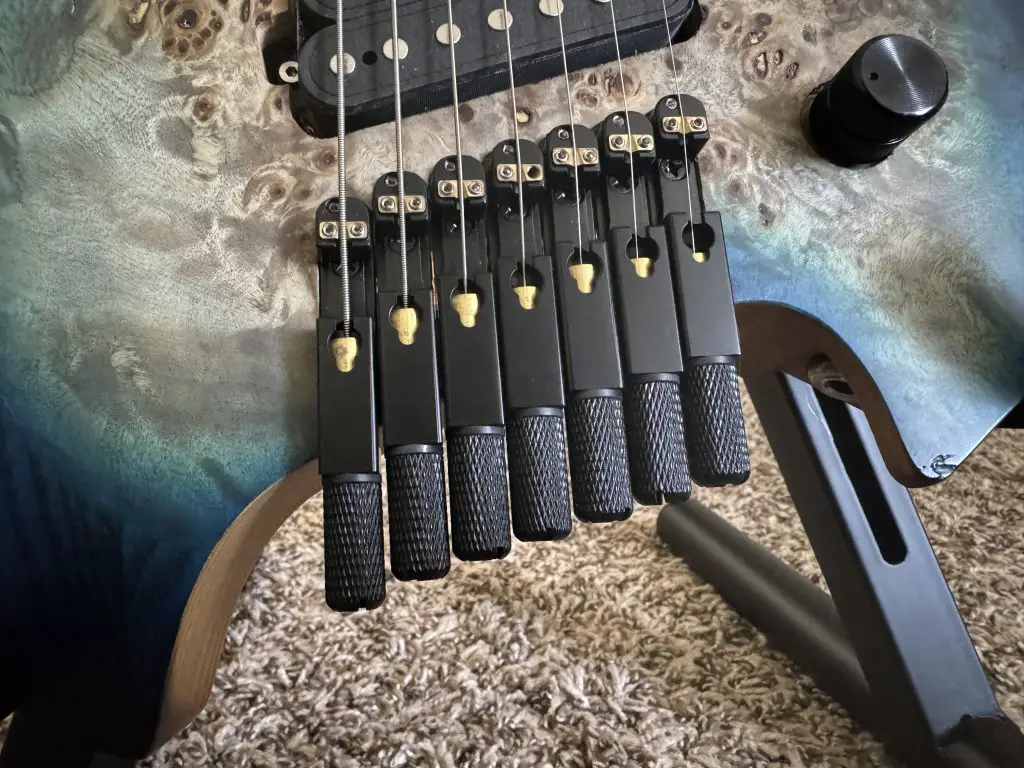
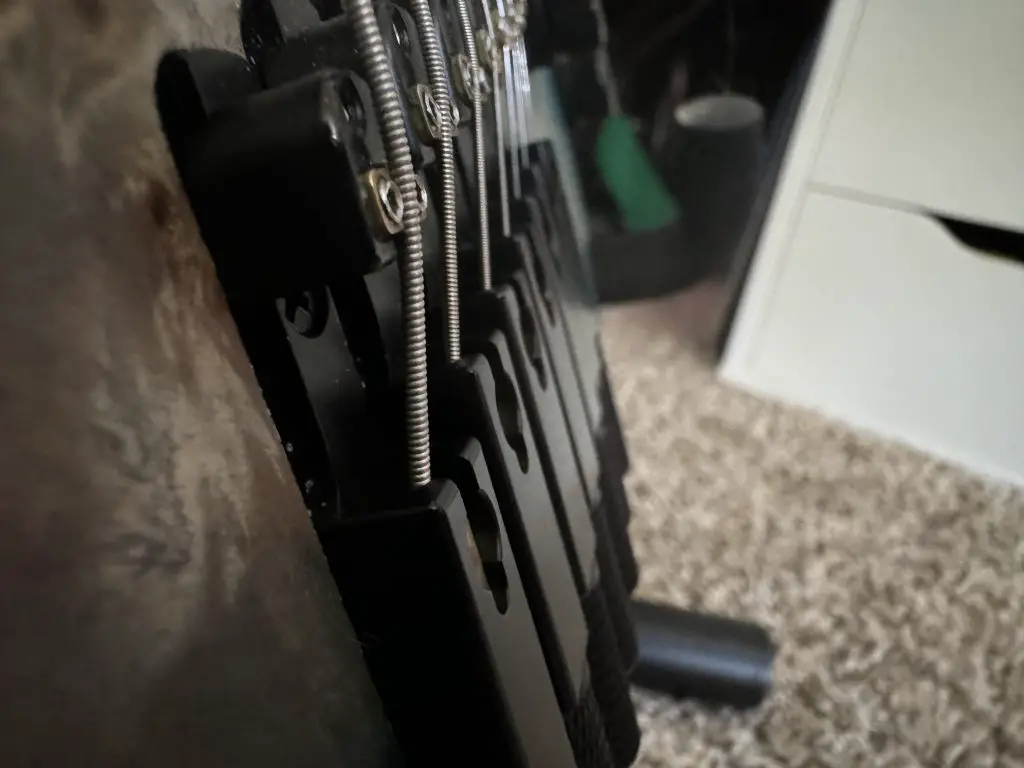
There have been different versions of bridge hardware used on NK guitars in the past, but the 2021 and newer versions are fantastic. They’re extremely adjustable, hold tuning well, and are easy to tune compared to other budget headless bridges.
You won’t need an extra tool to tune them, but sometimes they’re a bit tougher to turn than others. Lubing them up will improve things, but right out of the box this guitar only needed a little bit of working in on some strings.
Headstock (or lack thereof) and nut
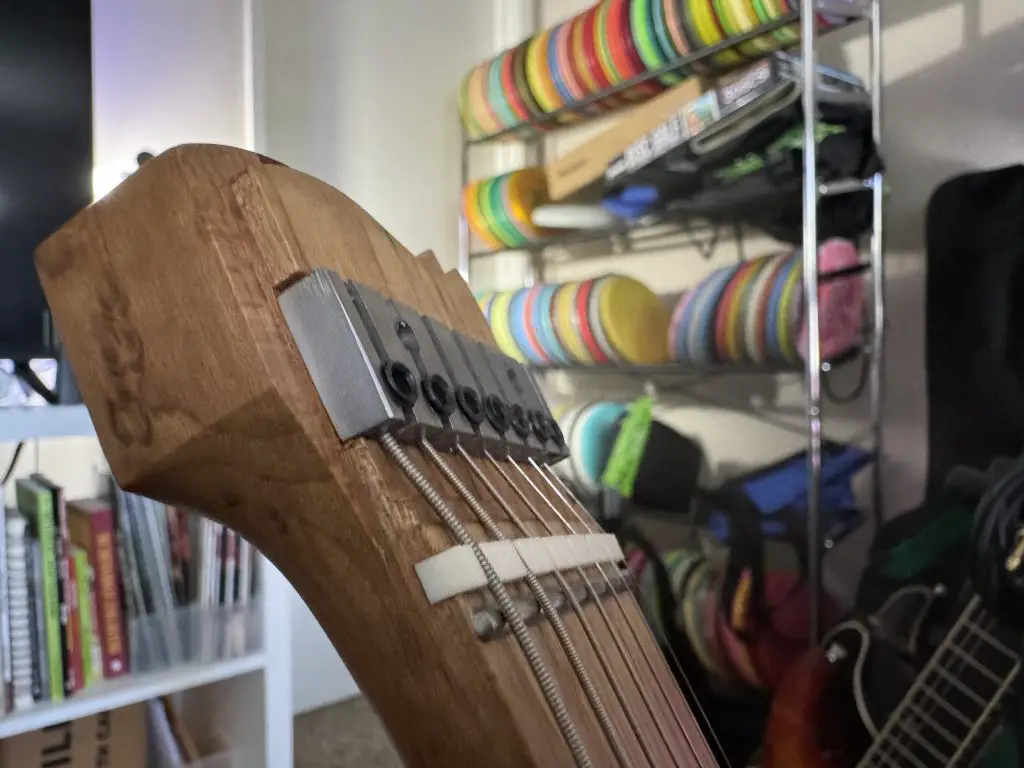
Some “headstocks” on headless guitars either look weird, work weird, or have hardware that can get out of the way. Thankfully, none of that is true with the current era of NK guitars.
The string retention hardware is low-profile and stays out of the way. You won’t end up running into it with your hand when playing chords on the first fret like some other budget headless guitars.
More importantly, each string only has a single set screw to keep it in place. Some of these guitars have two screws and it can be a bit tricky to restring and thankfully that’s not the case here.
Below that, you’ll find a 41.5mm bone nut and a zero fret. The nut is cut well, and the zero fret helps ensure good intonation and playability.
Playability
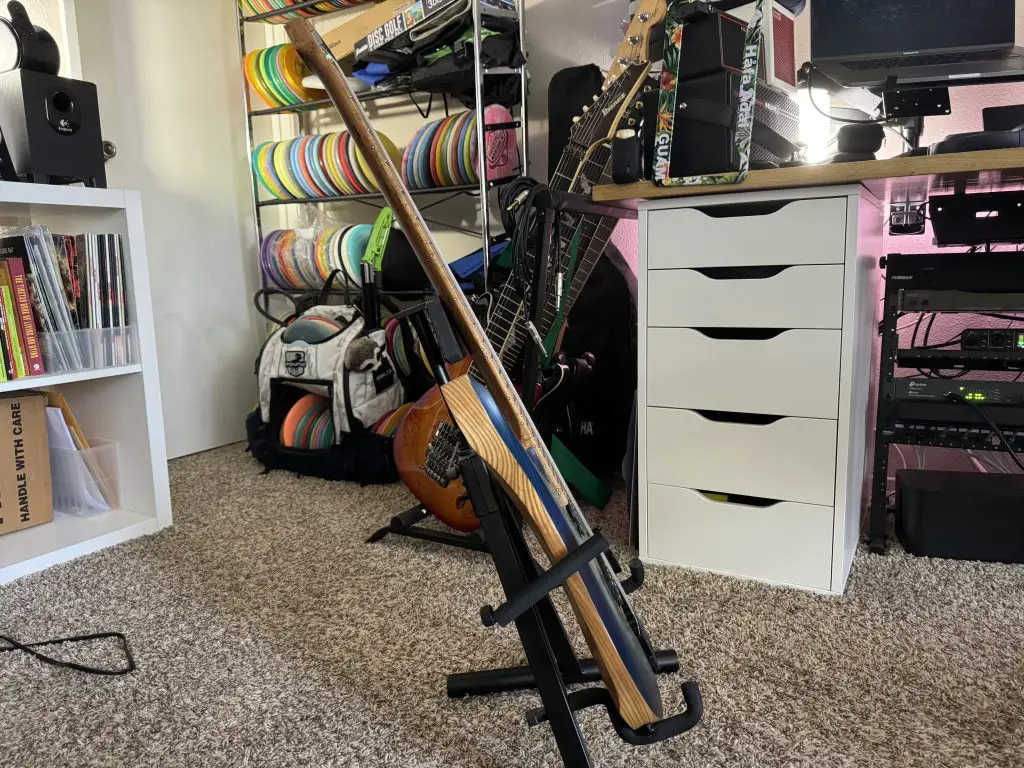
The big difference between a budget guitar and a “cheap” guitar is the playability. Fortunately, the NK plays well above its price tag.
Don’t get me wrong, it’s not perfect out of the box. But the action was nearly dialed in and I haven’t adjusted it since. I most likely will do this soon, but it’s not impeding my desire to pick it up.
The intonation, however, does need a bit more adjustment to get it right in tune up and down the fretboard, but that’s also expected from a lot of lower-priced guitars.
Overall though, it’s a very playable guitar out of the box, and even more so once you do the basic adjustments to bring the action and intonation up to your liking.
Update: I have since taken this guitar to the local shop for a setup job and there wasn’t much to be done. Action is almost the same as when it went in and the intonation only needed a bit of adjustment. Strung it up with a new set of D’Addario XS strings and it’s been fantastic!
Sound samples
In my opinion, the second most important part of a guitar is how it sounds. Unfortunately, this is often subjective and tough to quantify. After having this guitar for about half a year at this point, I can say that this guitar sounds like a guitar.
What do I mean by that? Well, in my opinion, this guitar sounds perfectly adequate. I don’t have any real game-changing complaints that can’t be overcome by a good tone-chasing session, and I feel that it’s usable exactly as it is.
Don’t get me wrong–the pickups aren’t the best in the world, but… Can it do cleans? Sure. Does it djent? Sure does! Could better pickups get better lows and more sparkly highs? Yeah, of course. But that shouldn’t stop you from buying this guitar–especially with how good it plays.
But to that end, I’ve recorded some basic sound samples to give you a decent idea of what to expect from this guitar in a variety of situations.
Pickup selections
I’ve recorded some basic cowboy chords in each pickup selection and pickup splits. I recorded one set of combinations and then duplicated them with different amp sim presets in Tonex to show different levels of gain. Those presets will be listed in each sample as well.
Clean tones
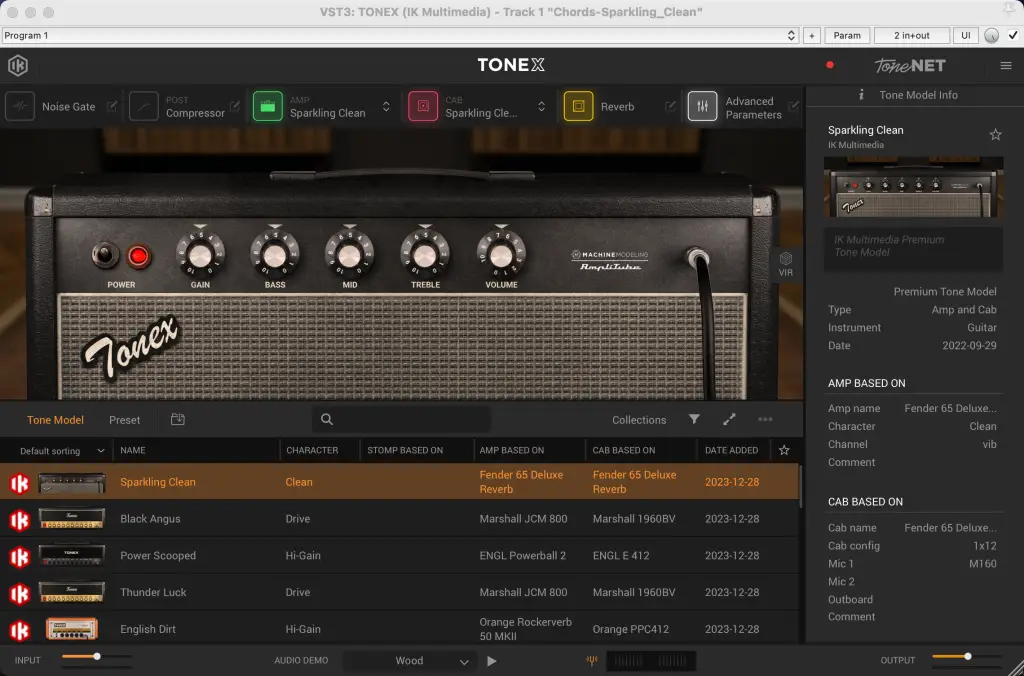
These samples are running through the Sparkling Clean tone model preset from Tonex, which is based on a Fender ’65 Deluxe Reverb. This tone was chosen because it wasn’t extremely bright nor flat and dull, but instead is a good all-around clean tone to try and represent the pickups as evenly as possible.
Lightly driven tones
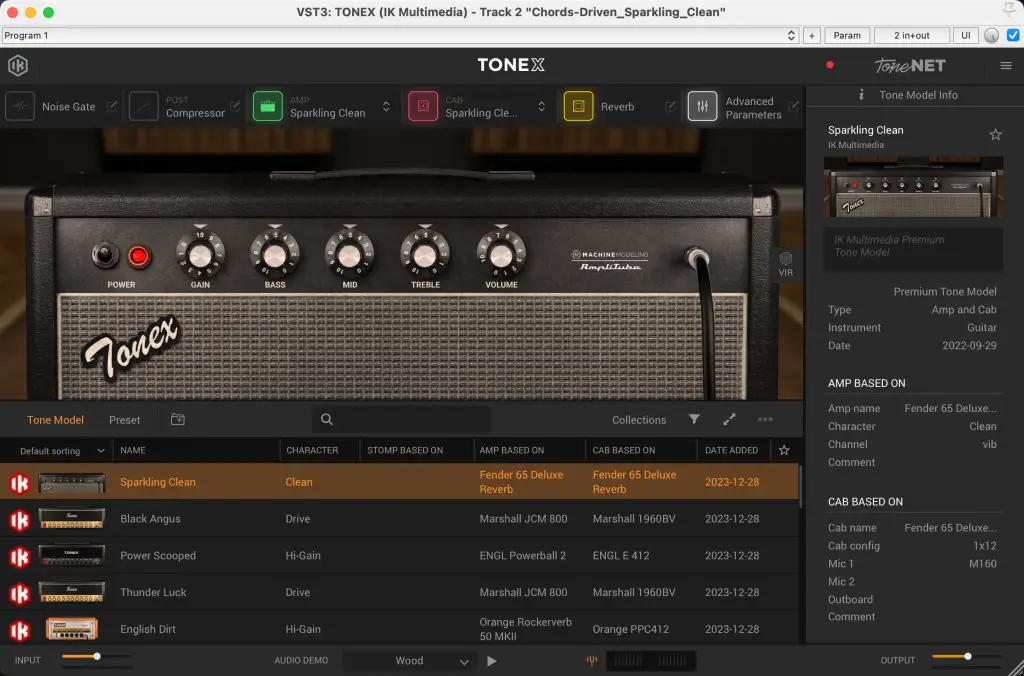
I turned up the gain on the Sparkling Clean preset to give the samples an “edge of breakup” sort of sound. It’s a bit of drive, but only just a bit.
Drive tones
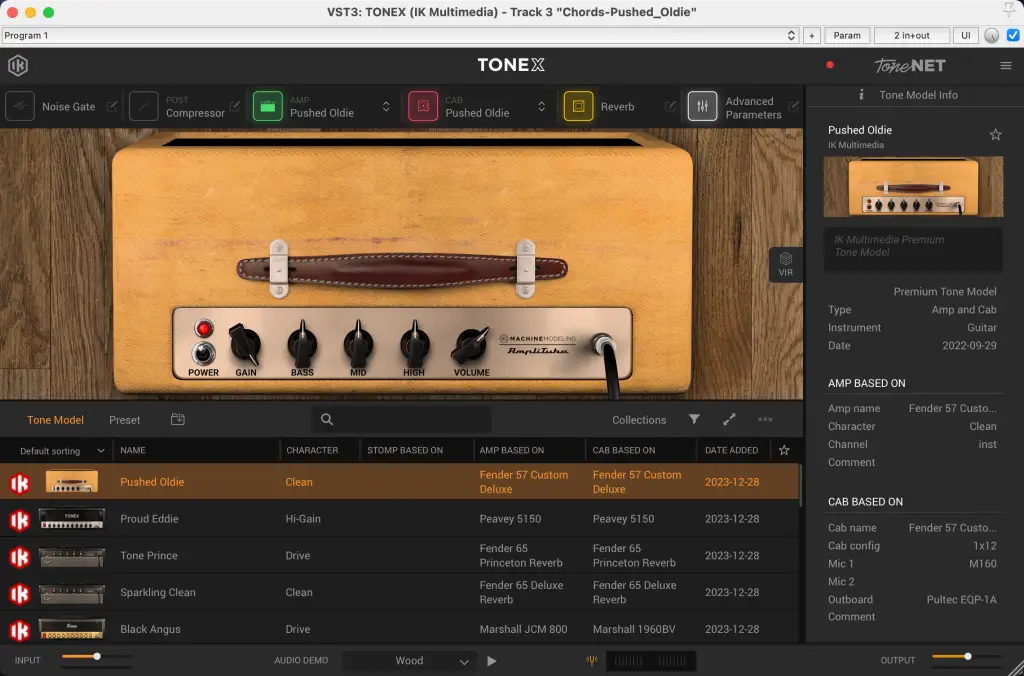
Switching to a more crunchy preset, the Pushed Oldie tone model is based on the Fender ’57 Custom Deluxe and gives a great overdrive tone.
Real songs
Chords are great and all, but how does it sound when playing a real song? Well, as much as I can play a real song, let’s find out! I’m not a great guitarist, so be warned.
Polyphia – “Goose”
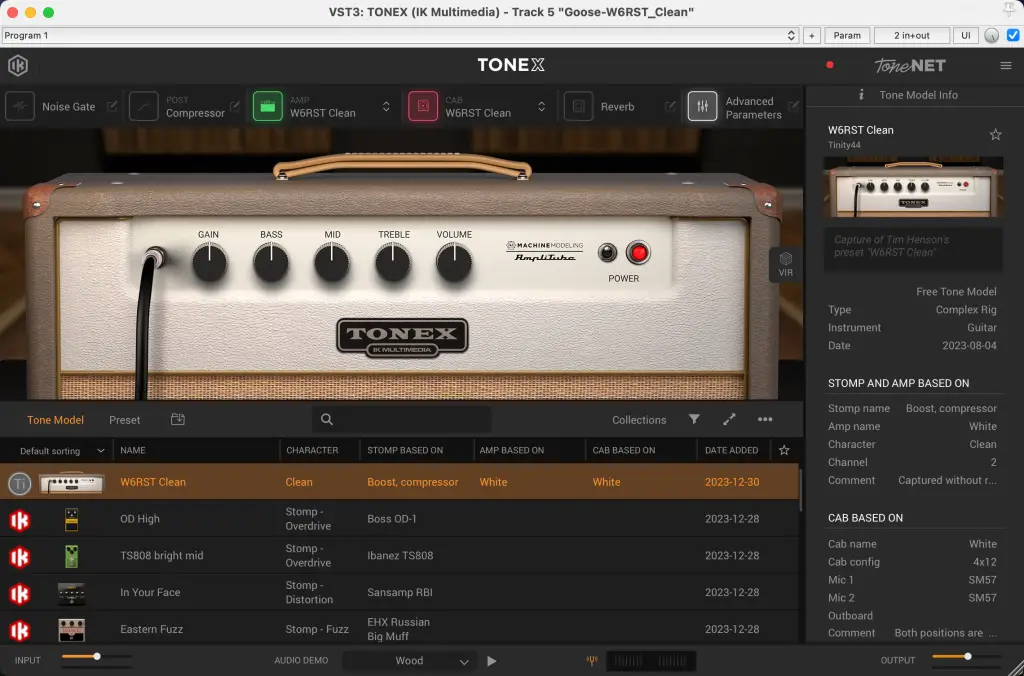
I love this song, but it’s a tough one for me to play, despite being one of the easier Polyphia songs to try and tackle.
This is technically tuned to drop-A, but as it’s a six-string song we’re effectively in standard, and I’m using the neck pickup in humbucker mode. The amp sim is using a ToneNET preset that was modeled off of the NeuralDSP Archetype: Tim Henson preset, using the White amp.
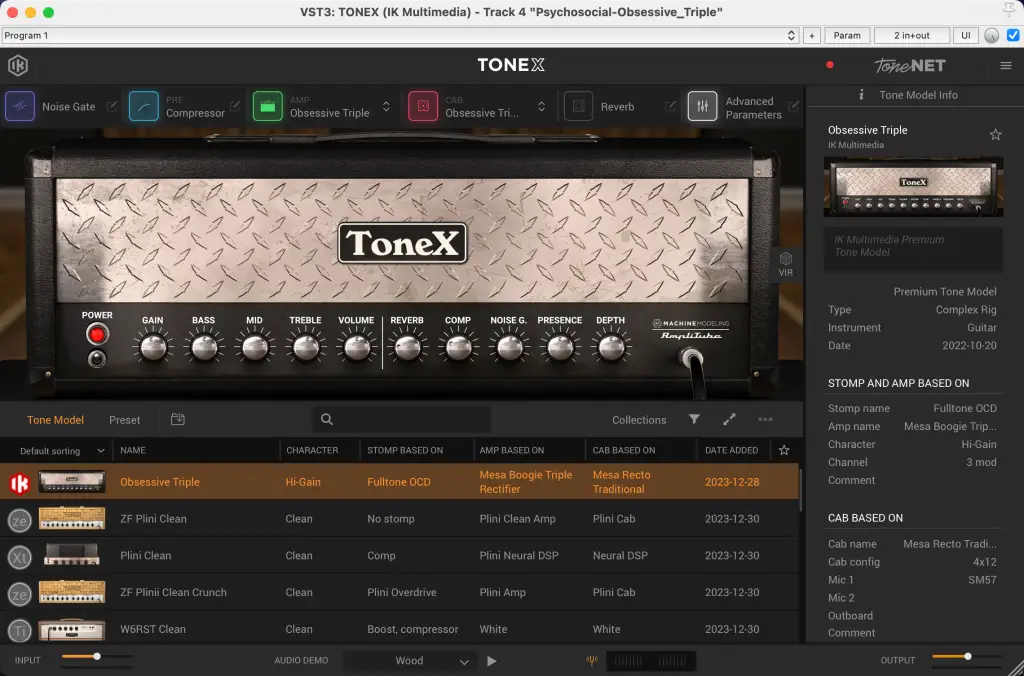
We’re using the bridge pickup in humbucker mode here and are tuned to drop-A. I believe this song is actually played on a six-string but works quite well on a 7-string. The amp is modeled from a Mesa Boogie Triple Rectifier, and this is the Obsessive Triple tone model.
Intervals – “Impulsively Responsible”
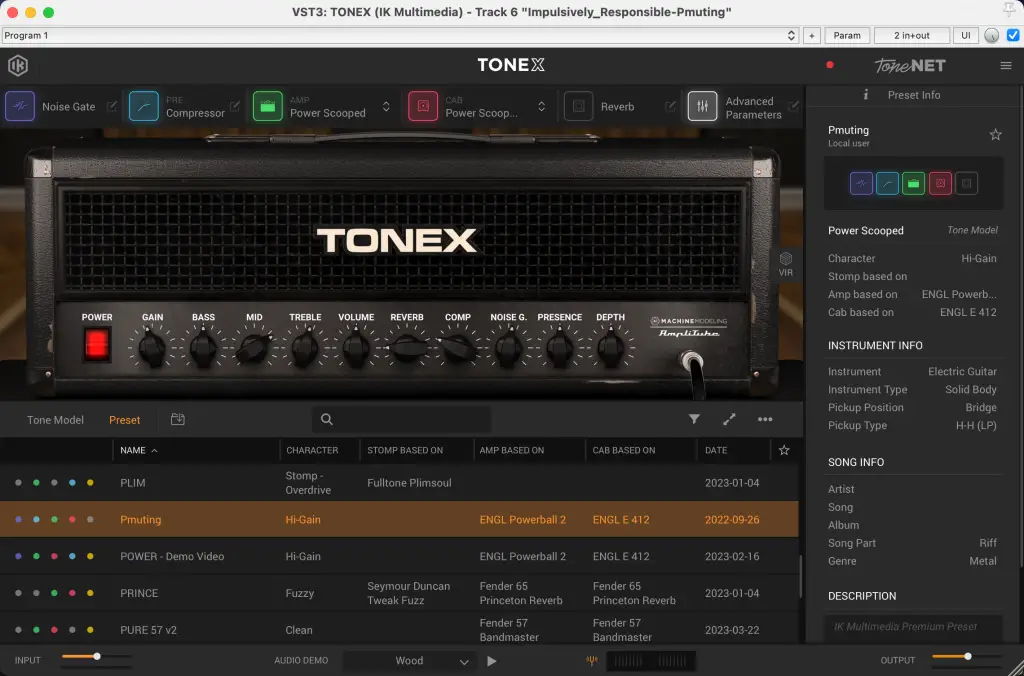
Intervals is another band full of super-hard songs I have no business learning, but the intro riff is so fun that I just had to try it. We’re on the bridge pickup in humbucker and tuned to drop-A still, but it’s a six-string standard tuning song so we just ignore the low string and play as usual.
The Tonex preset is the Pmuting preset based on the ENGL Powerball 2.
Value
The real strength of the NK guitars are their strong value. You get an excellently built guitar with high-end features and specs with a modern and comfy body design and excellent finishes, all at a fantastic bargain of a price.
For a fraction of the cost of a high-end “fancy” guitar brand, you can get a fantastic guitar that’s accessible to nearly anyone—and you wouldn’t feel like you were really missing out on much other than a brand name.
Where the value goes even further is the fact that NK will take custom orders and can do pretty much anything, as long as it’s near their wheelhouse. I’ve seen extremely custom inlay patterns, finishes, two-tone fretboards, custom pickups, control schemes, and more.
There are few brands out there in the extended range, headless multiscale modern guitars that offer this amount of features and potential customization, and it’s a breath of fresh air in the market.
NK vs Strandberg
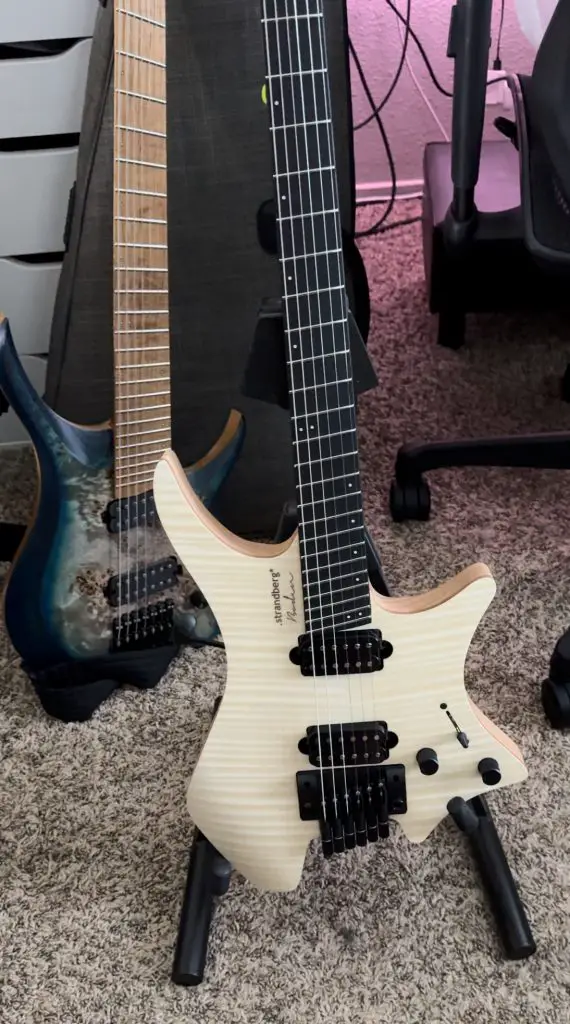
Throughout this article I’ve mentioned Strandberg frequently enough as a point of comparison, which is logical–the Strandberg Boden is basically what the NK guitars are based on. But how does the value-oriented NK guitar stack up against its obvious inspiration?
The Boden is a well-polished machine. It makes its price tag known, and you won’t doubt the reason for it once you play one. When I first unboxed my Strandberg Boden NX Prog 6 and held it, I knew I was in for a treat. Playing it immediately confirmed that.
But to be fair, that’s also how I felt about my NK, despite being at vastly different price points. They’re both high-quality instruments at their own levels, and I still reach for my NK and enjoy playing it.
The Boden is lighter and feels more nimble–makes sense, it’s a 6-string, not a 7-string, with a composite fretboard and a large chunk hollowed out for the trem. But even then it’s abnormally light.
They both balance quite well on a strap, and the neck on the NK feels slim and fast, as does the Boden. They do have different “slimness” feels though, as the Boden’s EndurNeck profile is angular and the NK’s asymmetrical neck flattens out to what feels like a thinner profile at the higher frets. They both feel excellent through the whole length of the neck though, and neither require major adjustments.
The Boden NX Prog ships with Suhr pickups and sounds better than the NK, no surprise there. But the NK pickups still hold their own, especially at the price. Even with the much-maligned NK Arcticsound pickups, I can’t say that I’m unhappy with the NK compared to the Boden.
If you’re looking for the TL;DR of the comparison between these two, and whether or not you should consider an NK, I think it’s best described as this: Is the Strandberg a better guitar? Yes, of course it is, in every single way. But is it 5-6 times better, as their prices would indicate? Not in the least.
I would say that, in terms of playability, the Strandberg is 2-3 times better, if we were talking dollars to dollars. But that’s not saying that the Strandberg is overvalued–no, exactly the opposite. I feel that the NK is that much undervalued. Yes, they use cheaper parts and woods, which contributes to its extreme value pricing, but the overall quality, playability, sound, and fit/finish of the NK really shine at its price point, and I have no qualms at all owning both an NK and Strandberg together.
Final thoughts
When it comes to the overall review of a guitar, in my opinion, comes down to whether I’d recommend the guitar to a new or beginner guitarist. This NK guitar meets that criteria easily.
You’d be hard-pressed to find another headless multiscale 6- or 7-string guitar with this quality and these features at this price. Or anywhere near it. NK has built a fantastic guitar and is building quite a loyal following because of their successes.
<div class="essb-pinterest-pro-content-marker" style="display: none !important;">

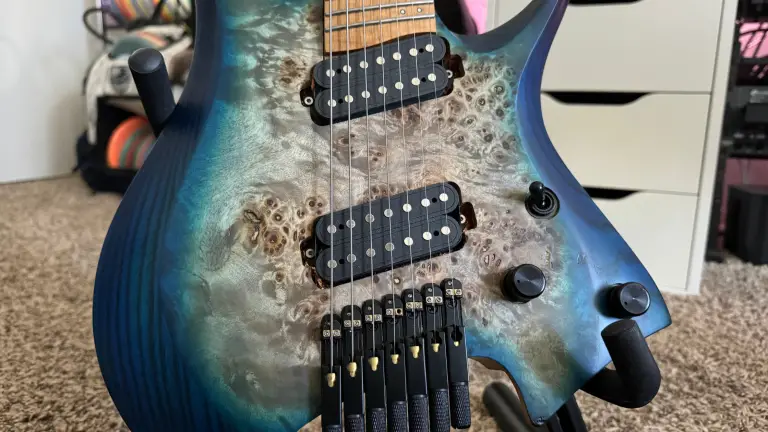
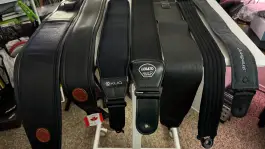

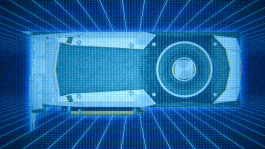

0 thoughts on “NK headless 7-string guitar review (2021 model)”